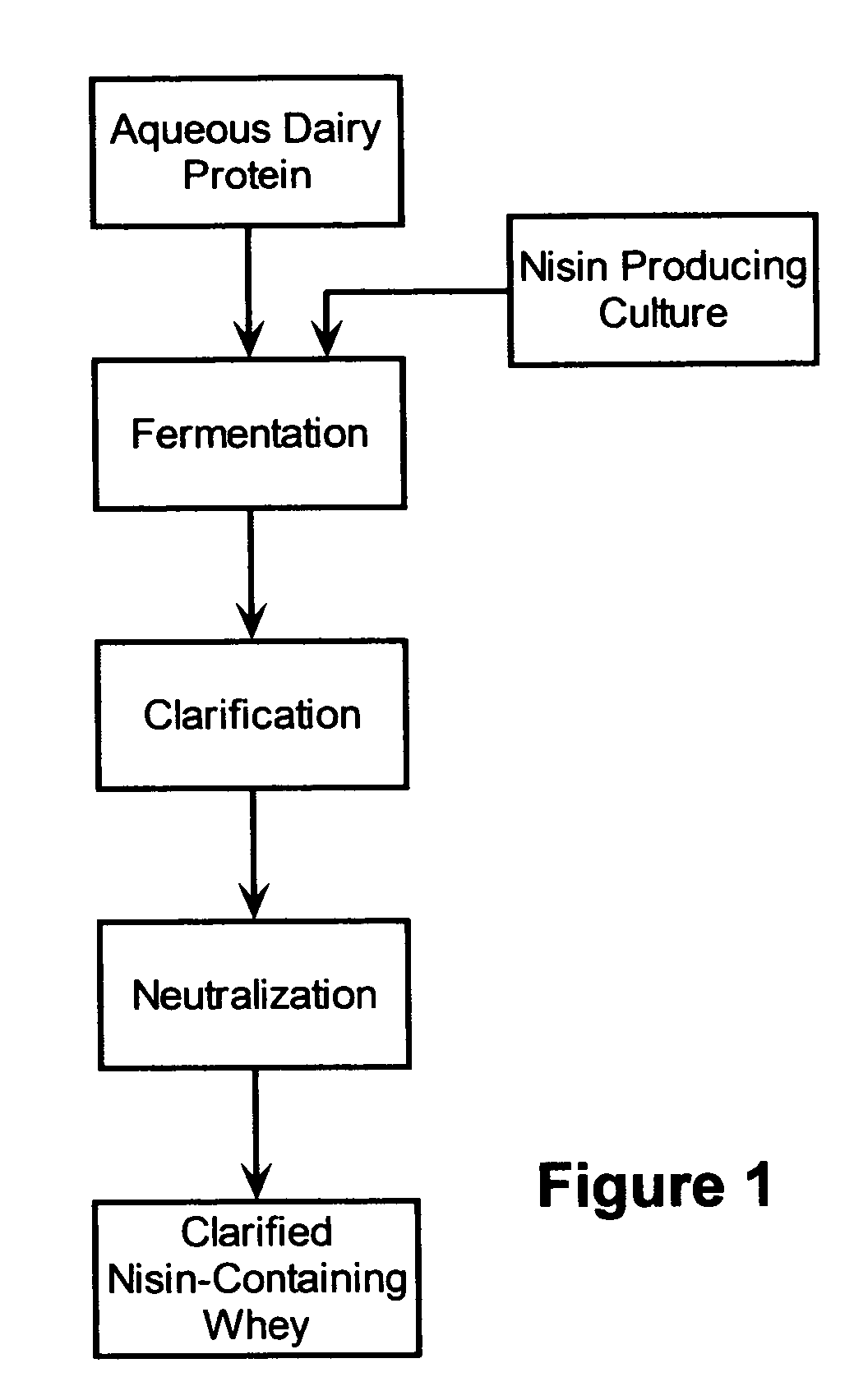Stabilization of fresh mozzarella cheese using fermented whey
a technology of fermented whey and fresh mozzarella cheese, which is applied in the field of food products, can solve the problems of longer shelf life, more perishable and more susceptible to microorganism growth, so as to reduce the growth of water-packed fresh mozzarella cheese to the level of detection, improve the safety of the product, and retard the growth
- Summary
- Abstract
- Description
- Claims
- Application Information
AI Technical Summary
Benefits of technology
Problems solved by technology
Method used
Image
Examples
example 1
[0046]This example provides a process for producing a nisin-containing whey yielding a high level of nisin-equivalent activity. Acid whey from fermentation of ricotta cheese (composition shown in Table 1) was fortified with whey protein concentrate (WPC) and a protein hydrolysate (N—Z amine™ from Quest International, Rochester, Minn.). The components were blended with water to form the fermentation medium as shown in Table 2.
[0047]
TABLE 1Compositions of a Typical Acid Set Ricotta Whey.CompositionContent (%)Lactose6.0Fat0.2Total protein0.5α-lactalbumin0.1β-lactoglobulin0.1Cross-linking77Non protein nitrogen0.06Calcium0.05Lactic acid0.04Ash0.9Total solids7.4pH5.8
[0048]
TABLE 2Fermentation medium formulation for the nisin-containingwhey composition production.ComponentContent (%)Ricotta whey50WPC1Protein hydrolysate0.1Water48.9
[0049]The blended formulation of Table 2 was pasteurized, cooled, and inoculated with a culture containing about 2×106 cfu / ml of a nisin-producing culture. The fe...
example 2
[0052]This example illustrates the yield (i.e., nisin-equivalent activity) at different pH and compositions of the fermentation medium. The fermentation was carried out as illustrated in Example 1, but the pH and composition of the base medium and supplement were varied as shown in Table 4. The results of the experiment are also shown in Table 4, which provides the yield as a function of different mediums and pH. The data shows that the fermentation preferably should be carried out under a controlled pH (generally at about 5.5) because the effect of fermentation pH on the yield of antimicrobial activity can be significant.
[0053]
TABLE 4Effect of Media Composition and FermentationpH on Antimicrobial Activity Yield.ActivityBase mediumSupplementpH(IU / ml)100% Ricotta whey 1% WPC, 0.1% N,Z-amine ™5.5175070% Ricotta whey1% WPC, 0.1% N,Z-amine ™5.5170250% Ricotta whey1% WPC, 0.1% N,Z-amine ™5.5162530% Ricotta whey1% WPC, 0.1% N,Z-amine ™5.5143350% Ricotta whey1% WPC, 0.1% N,Z-amine ™,5.5169...
example 3
[0054]This example illustrates the effect of pH on the yield during the microfiltration step. A fermented composition was prepared as illustrated in Example 1. The fermented composition contained high levels of solid suspensions and bacterial cells, and, thus, was not suitable to be added to the clear pack water of fresh mozzarella cheese. Different clarification methods, such as centrifugation and microfiltration, were tried. Microfiltration was most effective to remove cloudiness from the fermented whey.
[0055]The fermented whey was first filtered at a pH of about 5. At this pH, a significant amount of the antimicrobial activity was lost in the retentate as shown in Table 5. The material was filtered through a commercial microfiltration unit with a membrane pore size of 0.65 μm (CFP-6-D-6A, A / G Technology Corporation). Nisin is a small peptide with a molecular weight of 3500 Dalton; therefore, it theoretically should easily pass through the microfiltration membrane. As a matter of ...
PUM
 Login to View More
Login to View More Abstract
Description
Claims
Application Information
 Login to View More
Login to View More - R&D
- Intellectual Property
- Life Sciences
- Materials
- Tech Scout
- Unparalleled Data Quality
- Higher Quality Content
- 60% Fewer Hallucinations
Browse by: Latest US Patents, China's latest patents, Technical Efficacy Thesaurus, Application Domain, Technology Topic, Popular Technical Reports.
© 2025 PatSnap. All rights reserved.Legal|Privacy policy|Modern Slavery Act Transparency Statement|Sitemap|About US| Contact US: help@patsnap.com


